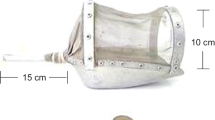Abstract
Organic pollution produces changes in the aquatic environment. Effluent reduces the dissolved-oxygen concentration as a result of decomposition of organic material and increases the levels of ammonia and phosphate, and both the biochemical oxygen demand (BOD) and chemical oxygen demand (COD). These affect the stream fauna so that different communities often show a zonation that characterizes distinct sections downstream of the discharge (Kolkwitz, 1950; Hynes, 1960; Liebmann, 1962; Hawkes, 1962; Chandler, 1970). This biotic zonation led to the traditional classification of water quality: a heavily polluted (polysaprobic) zone, a moderate (mesosaprobic) polluted zone (divided into two subzones, alpha and beta), and a slightly (oligo-saprobic) polluted zone, also known as the recovery zone, which indicates an advanced stage of self-purification of the river.
Access this chapter
Tax calculation will be finalised at checkout
Purchases are for personal use only
Preview
Unable to display preview. Download preview PDF.
Similar content being viewed by others
References
A.P.A.H., 1971, American Public Health Association: Standard Methods (13th ed.), Washington, D.C., 879 pp.
Bodergat, A. M., 1978, Un marquer instane de la pollution en cérium dans la zone de Cortiou (Rade sud de Marseille, Bouches-Rhône) Aurila speyeri Brady 1868 (Ostracoda, Podocopida), Doc. Lab. Géol. Fac. Sci. Lyon, H. S. 4:71–85.
Bromley, H.J., and Por, F.D., 1975, The metazoan fauna of a sewage-carrying wadi, Nahal Soreq (Judean Hills, Israel), Freshwater Biol. 5:121–133.
Bronstein, Z. S., 1947, Faune de l’URSS—Ostracodes des eaux douces, Edition de l’Academie des Sciences de l’URSS, Moscow, Leningrad, 339 pp [in Russian].
Chandler, J. R., 1970, A biological approach to water quality management, Water Pollut Cont. 69:415–421.
Ghetti, P. F., 1980, Biological indicators of the quality of running water, Bull. Zool. 47:381–390.
Hawkes, H. A., 1962, Biological aspects of river pollution, in River Pollution: 2. Causes and Effects (R. Klein, ed.) Butterworths, London, pp. 311–437.
Hynes, H. B. N., 1960, The Biology of Polluted Waters, Liverpool University Press, Liverpool.
Kaesler, R. L., Smith, S., and Whatley, R. C, 1979, Ostracoda and petroleum pollution in the Strait of Magellan, in Taxonomy, Biostratigraphy and Distribution of Ostracodes (Krstic, N., ed.), Proc. 7th Int. Symp. Ostracoda, Serbian Geological Society, Belgrade, pp. 237–242.
Klie, W., 1938. Ostracoda, in: Die Tierwelt Deutschlands und der angrenzenden Meeresteile, Vol. 34: Krebstiere Order Crustacea, Verlag Gustav Fischer,Jena, 230.
Kolkwitz, R., 1950, Oekologie der Saprobien. Ueber die Beziehungen der Wasserorganismen zur Umwelt: Schriftenreihe Ver. Wasser-Boden-und Lufthygiene, Vol. 4, pp. 1–64.
Lange-Bertalot, H., 1979, Pollution tolerance of diatoms as criterion for water quality estimation, Nova Hedweg. 64:285–304.
Liebmann, H., 1962, Handbuch der Frischwasser-und Abwasserbiology, R.Oldenbourg, Munich, 588 pp.
Margalef, R., 1953, Los crustaceos de las aguas continentales ibericas, Inst. Forestal Inves-tigaciones y Experiencias, Madrid.
Margalef, R., 1965, Los organismos indicadores en la limnologia, Inst. Forestal Investigaciones y Experiencias, Madrid.
Mezquita, F., Sanz-Brau, A., and Miracle, M.R., 1996, New data on freshwater ostracod assemblages (Crustacea, Ostracoda) from Cuenca (central Spain), Bull. Soc. Nat. Luxembourg 97:239–247.
Mezquita, F., Hernandez, R., and Rueda, J., 1999, Ecology and distribution of ostracods in polluted Mediteranean river: Palaeogeog. Palaeoclim. Palaeoecol. 148:87–103.
Milhau, B., Dekens, N., and Wouters, K., 1997, Evaluation de l’utilisation des Ostracodes comme bio-indicateurs potentiels de pollution. Application aux eaux de la Slack (Boulonnais, France), Ecologie 28:3–12.
Ortal, R., 1977, Biological key for pollution mapping of the streams of Israel: unpubl. report data, Nature Reserves Authority, Israel, Jerusalem, 3 pp.
Purper, I., and Wuerdig-Maciel, N. L., 1974. Occurrence of Heterocypris incongruens Ramdohr, 1808—Ostracoda—in Rio Grande do Sul, Brazil: Discussion on the allied genera, Cyprinotus, Hemicypris, Homocypris and Eucypris, Vol. 3, Pesquisas, Porto Alegre, pp. 69–91.
Rama Rao, S. V., Singh, V. P., and Mall, L. P., 1978, Pollution studies of the River Khan (Indore), India. 1: Biological assessment of pollution, Water Res. 12:555–559.
Ruiz Munoz, M., Gonzales-Regalado, L., and Borrego, J., 1994, Ostracodos y contaminacion: el estuario el rio Odiel (Huelva, SO Espania), Col. Paleontol. 46:175–189.
Rosenfeld, A., 1979, Seasonal distribution of recent ostracodes from Kiel Bay, Western Baltic Sea, Meyniana 31:59–82.
Rosenfeld, A. and Ortal, R., 1983, Ostracodes as indicators of water pollution in Nahal Harod, northern Israel, in: Applications of Ostracoda (R. F. Maddocks, ed.), Department of Geoscien-ces, University of Houston, pp. 229–237.
Wagner, C. W., 1957, Sur les Ostracodes du Quaternaire Récent des Bays-Bas et leur utilisation dans l’étude géologique des dépôts Holocènes, Mouton & Co., Paris, 259 pp.
Author information
Authors and Affiliations
Editor information
Editors and Affiliations
Rights and permissions
Copyright information
© 2000 Springer Science+Business Media New York
About this chapter
Cite this chapter
Rosenfeld, A., Ortal, R., Honigstein, A. (2000). Ostracodes as Indicators of River Pollution in Northern Israel. In: Martin, R.E. (eds) Environmental Micropaleontology. Topics in Geobiology, vol 15. Springer, Boston, MA. https://doi.org/10.1007/978-1-4615-4167-7_8
Download citation
DOI: https://doi.org/10.1007/978-1-4615-4167-7_8
Publisher Name: Springer, Boston, MA
Print ISBN: 978-1-4613-6870-0
Online ISBN: 978-1-4615-4167-7
eBook Packages: Springer Book Archive




